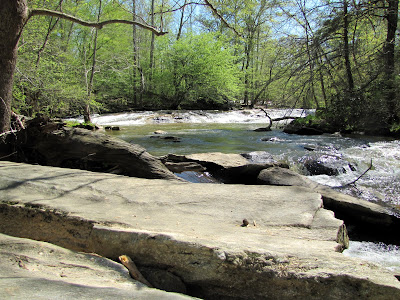 |
| From Andersonville |
(Part III of a three part serious on my trip to Andersonville, Part I here, Part II here)
After your stop at the Andersonville National Cemetery, there is one last place one feels compelled to see before departing the area. Across from the gate and the busy highway, stands the gate to the city of Andersonville. A quiet and infamous town, but home to something you won’t find anywhere else. It was here that the chief caretakers of the nefarious prison lived, most notable among them was the Commanding Officer Capt. Henry Wirz.

As you drive into the city, you can’t miss the one-of-a-kind item, I mentioned. It is a stone obelisk rising about 20 feet in the air planted smack dab in the middle of the road in the center of town. And this monument is erected in honor of Captain Wirz, the fabled Demon of Andersonville. Now there are Confederate Monuments scattered all throughout this state and country. And as a real part of our history, I don’t begrudge this fact, provided it is done respectfully and within context. But Captain Wirz was tried, convicted, and hanged for War Crimes. So this memorial is the only monument erected to honor a war criminal placed on American Soil. Some list Captain Wirz as the only man convicted of War Crimes during the Civil War, but there is also historical record of a Tennessee irregular combatant being executed, Champ Ferguson, though his status as a War Criminal is debatable. Another perplexing note, speaking to my feelings about visiting the POW museum, is that Wikipedia’s List of American War Criminals has only 10 entries: one from the 19th century, Henry Wirz; one from the 20th Century, William Calley, architect of the My Lai Massacre (1968); and the other eight entries are from the current century which stands at writing a mere 10 years old.

In addition to the monument, there are the offices of Captain Wirz on the corner. There’s a railroad crossing and a few railcars. There is a diorama exhibit of the prison, but as we arrived late in the day the whole place was closed. It looked pretty much like other small towns in Georgia, but the vacant nature and the area’s history gave it a decidedly eerie feel. Now I don’t buy into any paranormal activity whatsoever, but I can understand why the gullible and so inclined have repeated many Ghost Stories of Andersonville. On the positive side, there is a historical marker to the good Father Peter Whelan who ministered to the prisoners and prison keepers of Andersonville, serving God as if He was neither Blue nor Gray. If you are looking for a hero in this story, Father Whelan may be your best bet.
 |
| From Andersonville |
Behind the row of buildings on the left side, there is an interesting little city park. A small creek runs through it and they have gathered a number of old wooden shacks to make it quite photogenic. One of the shacks is a jail with a prisoner inside it. There is a kind of cheesy replica mill complete with Christmas lights. But the most fascinating part of the park is a cage containing two beautiful peacocks (well one beautiful peacock and one less glamorous peahen). As they are native to India (and I believe they are of the blue Indian variety), I have never seen any peafowl outside of a zoo or habitat community. To find these striking creatures in the small town of Andersonville’s city park was a perfect, albeit completely out of place, cherry on the top of a grand excursion.

In summary, the prison recalls an awful time in our history. The POW Museum makes us consider our collective humanity. The Prison site makes us shudder at the prospect of how low man can sink. The Cemetery makes us reflect on those who carried our banner. And the city makes us question our views of the past. Our jaunt to Andersonville was something that moved me deeply. I would offer that the historical impact of this area is second only to the Martin Luther King Historic Sites and our Civil Rights Legacy. Now, I’m looking forward to a better meaning of the word, “Civil.”





















